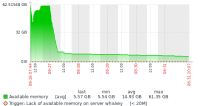We run a pretty large database (about 5.5TB currently), and we were running into issues with the growing history list length that was well known under 10.11.6.
We upgraded to 10.11.9 (10.11.8 first on some servers), and we immediately noticed that the memory usage was wildly different. 10.11.6 seemed very good at freeing memory, and it was great to see an accurate representation of how many resources the servers are actually using.
With 10.11.9, you can see that the graph does a reverse hockey stick. It maximizes allocated memory based on innodb_buffer_pool_size, and then stays occupied, hardly fluctuating.
We had seen this same kind of usage in MariaDB 10.3 and 10.6, so it was really nice when earlier 10.11 had what looked like much more robust memory handling. We wouldn't have a big problem with it except that one of our replicas unexpectedly OOMed over the weekend.
So, what changed from 10.11.6 to 10.11.8? Is there a way to set more aggressive memory management?
{"report":{"fcp":5896.399999856949,"ttfb":1865,"pageVisibility":"visible","entityId":130577,"key":"jira.project.issue.view-issue","isInitial":true,"threshold":1000,"elementTimings":{},"userDeviceMemory":8,"userDeviceProcessors":64,"apdex":0,"journeyId":"214c8f2e-8e73-49b3-9b10-6a6ef2775a93","navigationType":0,"readyForUser":5962.200000047684,"redirectCount":0,"resourceLoadedEnd":5345.5,"resourceLoadedStart":1965.2000000476837,"resourceTiming":[{"duration":1585.2999999523163,"initiatorType":"link","name":"https://jira.mariadb.org/s/2c21342762a6a02add1c328bed317ffd-CDN/lu2cib/820016/12ta74/0a8bac35585be7fc6c9cc5a0464cd4cf/_/download/contextbatch/css/_super/batch.css","startTime":1965.2000000476837,"connectEnd":0,"connectStart":0,"domainLookupEnd":0,"domainLookupStart":0,"fetchStart":1965.2000000476837,"redirectEnd":0,"redirectStart":0,"requestStart":0,"responseEnd":3550.5,"responseStart":0,"secureConnectionStart":0},{"duration":1585.3999998569489,"initiatorType":"link","name":"https://jira.mariadb.org/s/7ebd35e77e471bc30ff0eba799ebc151-CDN/lu2cib/820016/12ta74/494e4c556ecbb29f90a3d3b4f09cb99c/_/download/contextbatch/css/jira.browse.project,project.issue.navigator,jira.view.issue,jira.general,jira.global,atl.general,-_super/batch.css?agile_global_admin_condition=true&jag=true&jira.create.linked.issue=true&slack-enabled=true&whisper-enabled=true","startTime":1965.5,"connectEnd":0,"connectStart":0,"domainLookupEnd":0,"domainLookupStart":0,"fetchStart":1965.5,"redirectEnd":0,"redirectStart":0,"requestStart":0,"responseEnd":3550.899999856949,"responseStart":0,"secureConnectionStart":0},{"duration":2882.2999999523163,"initiatorType":"script","name":"https://jira.mariadb.org/s/0917945aaa57108d00c5076fea35e069-CDN/lu2cib/820016/12ta74/0a8bac35585be7fc6c9cc5a0464cd4cf/_/download/contextbatch/js/_super/batch.js?locale=en","startTime":1965.7000000476837,"connectEnd":1965.7000000476837,"connectStart":1965.7000000476837,"domainLookupEnd":1965.7000000476837,"domainLookupStart":1965.7000000476837,"fetchStart":1965.7000000476837,"redirectEnd":0,"redirectStart":0,"requestStart":3553.5,"responseEnd":4848,"responseStart":3643.2999999523163,"secureConnectionStart":1965.7000000476837},{"duration":3379.600000143051,"initiatorType":"script","name":"https://jira.mariadb.org/s/2d8175ec2fa4c816e8023260bd8c1786-CDN/lu2cib/820016/12ta74/494e4c556ecbb29f90a3d3b4f09cb99c/_/download/contextbatch/js/jira.browse.project,project.issue.navigator,jira.view.issue,jira.general,jira.global,atl.general,-_super/batch.js?agile_global_admin_condition=true&jag=true&jira.create.linked.issue=true&locale=en&slack-enabled=true&whisper-enabled=true","startTime":1965.8999998569489,"connectEnd":1965.8999998569489,"connectStart":1965.8999998569489,"domainLookupEnd":1965.8999998569489,"domainLookupStart":1965.8999998569489,"fetchStart":1965.8999998569489,"redirectEnd":0,"redirectStart":0,"requestStart":3553.7999999523163,"responseEnd":5345.5,"responseStart":3686,"secureConnectionStart":1965.8999998569489},{"duration":2031.7999999523163,"initiatorType":"script","name":"https://jira.mariadb.org/s/a9324d6758d385eb45c462685ad88f1d-CDN/lu2cib/820016/12ta74/c92c0caa9a024ae85b0ebdbed7fb4bd7/_/download/contextbatch/js/atl.global,-_super/batch.js?locale=en","startTime":1966.0999999046326,"connectEnd":1966.0999999046326,"connectStart":1966.0999999046326,"domainLookupEnd":1966.0999999046326,"domainLookupStart":1966.0999999046326,"fetchStart":1966.0999999046326,"redirectEnd":0,"redirectStart":0,"requestStart":3553.899999856949,"responseEnd":3997.899999856949,"responseStart":3898.5,"secureConnectionStart":1966.0999999046326},{"duration":2016.2999999523163,"initiatorType":"script","name":"https://jira.mariadb.org/s/d41d8cd98f00b204e9800998ecf8427e-CDN/lu2cib/820016/12ta74/1.0/_/download/batch/jira.webresources:calendar-en/jira.webresources:calendar-en.js","startTime":1966.2999999523163,"connectEnd":1966.2999999523163,"connectStart":1966.2999999523163,"domainLookupEnd":1966.2999999523163,"domainLookupStart":1966.2999999523163,"fetchStart":1966.2999999523163,"redirectEnd":0,"redirectStart":0,"requestStart":3554.0999999046326,"responseEnd":3982.5999999046326,"responseStart":3814.7999999523163,"secureConnectionStart":1966.2999999523163},{"duration":2084,"initiatorType":"script","name":"https://jira.mariadb.org/s/d41d8cd98f00b204e9800998ecf8427e-CDN/lu2cib/820016/12ta74/1.0/_/download/batch/jira.webresources:calendar-localisation-moment/jira.webresources:calendar-localisation-moment.js","startTime":1966.5999999046326,"connectEnd":1966.5999999046326,"connectStart":1966.5999999046326,"domainLookupEnd":1966.5999999046326,"domainLookupStart":1966.5999999046326,"fetchStart":1966.5999999046326,"redirectEnd":0,"redirectStart":0,"requestStart":3554.399999856949,"responseEnd":4050.5999999046326,"responseStart":4048.899999856949,"secureConnectionStart":1966.5999999046326},{"duration":1585.5999999046326,"initiatorType":"link","name":"https://jira.mariadb.org/s/b04b06a02d1959df322d9cded3aeecc1-CDN/lu2cib/820016/12ta74/a2ff6aa845ffc9a1d22fe23d9ee791fc/_/download/contextbatch/css/jira.global.look-and-feel,-_super/batch.css","startTime":1966.7999999523163,"connectEnd":0,"connectStart":0,"domainLookupEnd":0,"domainLookupStart":0,"fetchStart":1966.7999999523163,"redirectEnd":0,"redirectStart":0,"requestStart":0,"responseEnd":3552.399999856949,"responseStart":0,"secureConnectionStart":0},{"duration":2083.600000143051,"initiatorType":"script","name":"https://jira.mariadb.org/rest/api/1.0/shortcuts/820016/47140b6e0a9bc2e4913da06536125810/shortcuts.js?context=issuenavigation&context=issueaction","startTime":1966.8999998569489,"connectEnd":1966.8999998569489,"connectStart":1966.8999998569489,"domainLookupEnd":1966.8999998569489,"domainLookupStart":1966.8999998569489,"fetchStart":1966.8999998569489,"redirectEnd":0,"redirectStart":0,"requestStart":3554.5,"responseEnd":4050.5,"responseStart":4048.0999999046326,"secureConnectionStart":1966.8999998569489},{"duration":1585.5,"initiatorType":"link","name":"https://jira.mariadb.org/s/3ac36323ba5e4eb0af2aa7ac7211b4bb-CDN/lu2cib/820016/12ta74/d176f0986478cc64f24226b3d20c140d/_/download/contextbatch/css/com.atlassian.jira.projects.sidebar.init,-_super,-project.issue.navigator,-jira.view.issue/batch.css?jira.create.linked.issue=true","startTime":1967.2000000476837,"connectEnd":0,"connectStart":0,"domainLookupEnd":0,"domainLookupStart":0,"fetchStart":1967.2000000476837,"redirectEnd":0,"redirectStart":0,"requestStart":0,"responseEnd":3552.7000000476837,"responseStart":0,"secureConnectionStart":0},{"duration":2083,"initiatorType":"script","name":"https://jira.mariadb.org/s/5d5e8fe91fbc506585e83ea3b62ccc4b-CDN/lu2cib/820016/12ta74/d176f0986478cc64f24226b3d20c140d/_/download/contextbatch/js/com.atlassian.jira.projects.sidebar.init,-_super,-project.issue.navigator,-jira.view.issue/batch.js?jira.create.linked.issue=true&locale=en","startTime":1967.2999999523163,"connectEnd":1967.2999999523163,"connectStart":1967.2999999523163,"domainLookupEnd":1967.2999999523163,"domainLookupStart":1967.2999999523163,"fetchStart":1967.2999999523163,"redirectEnd":0,"redirectStart":0,"requestStart":3554.5999999046326,"responseEnd":4050.2999999523163,"responseStart":4000.7999999523163,"secureConnectionStart":1967.2999999523163},{"duration":3286.199999809265,"initiatorType":"script","name":"https://jira.mariadb.org/s/d41d8cd98f00b204e9800998ecf8427e-CDN/lu2cib/820016/12ta74/1.0/_/download/batch/jira.webresources:bigpipe-js/jira.webresources:bigpipe-js.js","startTime":1969.2000000476837,"connectEnd":1969.2000000476837,"connectStart":1969.2000000476837,"domainLookupEnd":1969.2000000476837,"domainLookupStart":1969.2000000476837,"fetchStart":1969.2000000476837,"redirectEnd":0,"redirectStart":0,"requestStart":4000.0999999046326,"responseEnd":5255.399999856949,"responseStart":5068.200000047684,"secureConnectionStart":1969.2000000476837},{"duration":3310.0999999046326,"initiatorType":"script","name":"https://jira.mariadb.org/s/d41d8cd98f00b204e9800998ecf8427e-CDN/lu2cib/820016/12ta74/1.0/_/download/batch/jira.webresources:bigpipe-init/jira.webresources:bigpipe-init.js","startTime":2033.7999999523163,"connectEnd":2033.7999999523163,"connectStart":2033.7999999523163,"domainLookupEnd":2033.7999999523163,"domainLookupStart":2033.7999999523163,"fetchStart":2033.7999999523163,"redirectEnd":0,"redirectStart":0,"requestStart":4170.700000047684,"responseEnd":5343.899999856949,"responseStart":5255.599999904633,"secureConnectionStart":2033.7999999523163},{"duration":530.5,"initiatorType":"xmlhttprequest","name":"https://jira.mariadb.org/rest/webResources/1.0/resources","startTime":5069.5,"connectEnd":5069.5,"connectStart":5069.5,"domainLookupEnd":5069.5,"domainLookupStart":5069.5,"fetchStart":5069.5,"redirectEnd":0,"redirectStart":0,"requestStart":5564.5,"responseEnd":5600,"responseStart":5597.899999856949,"secureConnectionStart":5069.5}],"fetchStart":0,"domainLookupStart":0,"domainLookupEnd":0,"connectStart":0,"connectEnd":0,"requestStart":1368,"responseStart":1865,"responseEnd":2037,"domLoading":1934,"domInteractive":6363,"domContentLoadedEventStart":6363,"domContentLoadedEventEnd":6444,"domComplete":8139,"loadEventStart":8139,"loadEventEnd":8140,"userAgent":"Mozilla/5.0 AppleWebKit/537.36 (KHTML, like Gecko; compatible; ClaudeBot/1.0; +claudebot@anthropic.com)","marks":[{"name":"bigPipe.sidebar-id.start","time":6302.299999952316},{"name":"bigPipe.sidebar-id.end","time":6303.200000047684},{"name":"bigPipe.activity-panel-pipe-id.start","time":6303.799999952316},{"name":"bigPipe.activity-panel-pipe-id.end","time":6308.399999856949},{"name":"activityTabFullyLoaded","time":6472.5}],"measures":[],"correlationId":"d21be5c0e36d4a","effectiveType":"4g","downlink":10,"rtt":0,"serverDuration":144,"dbReadsTimeInMs":22,"dbConnsTimeInMs":32,"applicationHash":"9d11dbea5f4be3d4cc21f03a88dd11d8c8687422","experiments":[]}}
Bug
Major
MDEV-36197 Implement Buffer Pool Auto-Scaling Based on RAM Availability
MDEV-29445 reorganise innodb buffer pool (and remove buffer pool chunks)
MDEV-24670 avoid OOM by linux kernel co-operative memory management
MDEV-29445 reorganise innodb buffer pool (and remove buffer pool chunks)
MDEV-34753 memory pressure - erroneous termination condition
MDEV-35424 False alarm/crash: innodb_fatal_semaphore_wait_threshold was exceeded for dict_sys.latch
MDEV-29432 innodb huge pages reclaim
MDEV-31953 madvise(frame, srv_page_size, MADV_FREE) is causing a performance regression


Reviewing the changelogs for 10.11.7 and 10.11.8, all I can see is an entry for 10.11.7:
MDEV-24670)